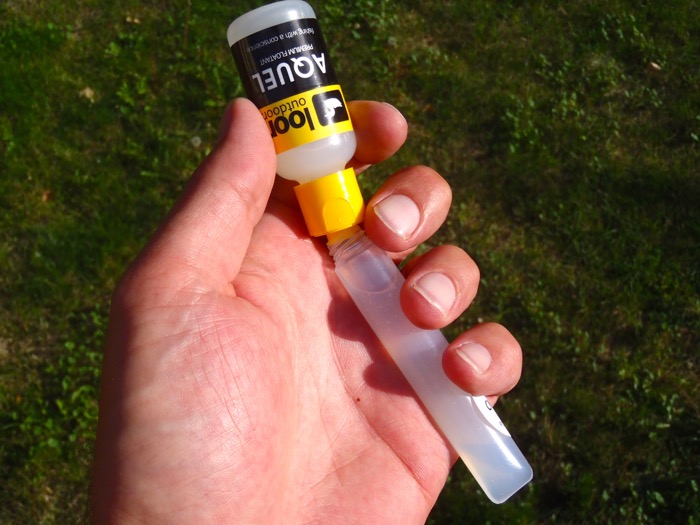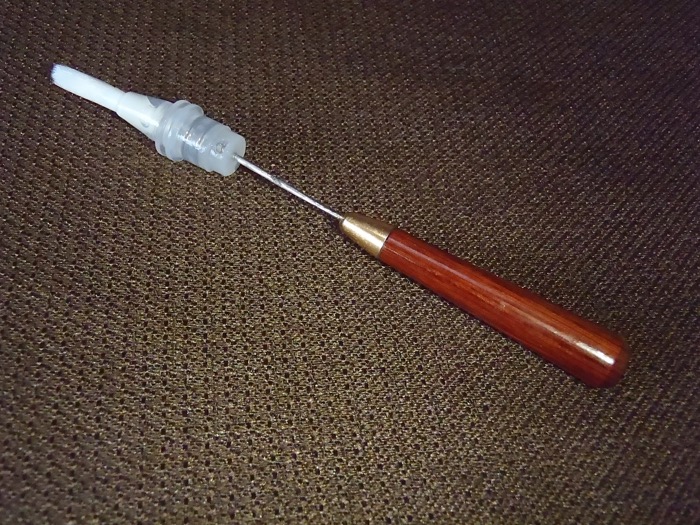
Even though in the last few years I’ve almost exclusively fished subsurface flies like sakasa kebari since adopting tenkara for trout, during the course of my overall fly fishing career, I’ve probably used gallons of fly floatant on dry flies; mostly paste such as Loon’s Aquel. And while it’s effective, I’ve never been happy with the application process. The nozzle on most floatant bottles is pretty crude and clumsy, forcing you to have to work the paste in with your fingers if you want to get full coverage on the hackle, dubbing, wing, etc. And it’s not only messy (leaving stubborn residue on your fingertips), but often inefficient because it’s easy to over-apply (especially on hot days when the paste becomes less viscous). This is not only a waste of money, but can actually have the opposite intended effect of sinking the fly instead of making it float by weighing it down.
I was recently thinking about a better way to apply floatant and the first thing that came to mind was a soft-haired brush (like the camel-hair ones that come with nail polish) that would allow you to evenly and efficiently apply the paste to the entire anatomy of a dry fly without crushing the hackle or wings, over-applying clumps, or leaving your fingers feel like they’re coated with WD-40.
My first approach was to see what was available locally. So I hit Home Depot and my local Safeway to see if they had anything that I might be able to turn into a DIY brush applicator. In the photo below, you’ll see three of my first experiments. And after that, you’ll see why they failed from left to right …

- HDX Grout Dispenser. I got this bottle at home Depot but the bristles were way too thick and stiff–thus defeating the purpose of applying the floatant evenly and without crushing hackles. Plus, with an 8 oz. capacity, it was just WAY too big. No one would want to carry that in their vest, chest pack, or sling pack.
- KISS Nail glue. Perfect size, but hard to clean out and refill and you would have to hold the open bottle in-hand while applying, making it precarious to spill (especially if you’re wading mid-stream). It would just require too much superfluous dexterity to use effectively.
- Insta-Dri nail glue. Good size, but same problems as #2, plus it’s a glass bottle, is much heavier, and could break if you dropped it on a rock.
What I wanted was the convenience of a squeeze bottle like most commercial floatants come in combined with the superior coverage of a soft-bristled brush tip. I Googled the heck out of it and could not find one manufacturer in the fly fishing industry that made one. So, I got creative.
I eventually found a bottle manufacturer named East Hill Industries that makes pretty much exactly what I was looking for. It’s a refillable squeeze-tube with a brush tip applicator that comes in a variety of sizes. I asked for a free sample of the 1.5 oz. capacity since that seems to be the industry standard amount for most fly floatant manufacturers and is much more compact that anything I was able to find locally. The box arrived on my doorstep within a couple of days and I think I’m on to something.
First of all, the bottles are easy to fill. Take the nozzle off and the male end of the floatant bottle will easily fit in–no funnel required. Just squeeze until it’s full and you’re good to go.

One note: I think these bottles are meant for makeup application and are spring activated. The pressure required to activate the spring would be too much to apply to a dry fly without damaging its profile (which defeats the purpose) so I recommend using a bodkin to poke a hole in the base of the nozzle in order to let the paste flow freely …

Second of all, the bristles (while synthetic rather than than camel hair ones that usually come with nail polish) are still very pliable and offer much more thorough coverage than some of the other brush-tipped bottles I’ve played around with and make it easy to really work into the fly’s materials without causing trauma to the wings or hackle; saving you the extra step of “fluffing it up” after application.
Thirdly, they apparently come in two bristle tip sizes–one for bigger flies and one for smaller flies. That’s a nice option:

Once you fill the bottle, applying the floatant and really working it into the fly is really easy. Just squeeze the tube so that some paste oozes into the bristles and lightly paint it on the wings and hackle, making sure you also poke it into the body material. No mess, no fuss, no waste, and better coverage.

I only took the photo above in my vise because I don’t have three hands to hold a fly, floatant bottle, and focus a camera at the same time. But on the stream, it’s just as easy to use as any commercially available floatant today.
While I feel a little unethical posting this because I got a free sample from a wholesaler I have no intention of buying 1,000 units from, it was (I think) a successful experiment and I hope it will raise awareness to floatant manufacturers that there is a better dispensing option than the status quo nozzle that would be easy to manufacture. Oh, and one more thing … while these bottles come with a cap, if a floatant manufacturer did conspire with a bottle manufacturer to produce this design, I would recommend adding a cap retainer just so there’s one less thing to hold in your hand while you’re greasing up your favorite floating fly.








Dazzling White Professional Strength Teeth Whitening Pens from the Dollar Tree work for me.
Easy to refill (Small Amount Though) and is a twist type applicator……
What a great idea. That would have been handy when I was applying Aquel to #24 Trico spinners yesterday. I think an empty Frog’s Fanny bottle might work well also, but not as well as your idea. Thanks for sharing.
Also check out water brush. They are used for watercolor paints.
I think that’s a great idea Jason. What do you think the chance of the floatant manufactures of giving this a try? I think I will give the one Walt posted a try. Keep us posted if you here anything from the manufactures. Thanks for all your post I enjoy reading them.
Thanks Bradley, I think there’s a fair chance the manufacturers could pick up the idea. Maybe I should approach them with the idea since probably most of them will not see my blog post. But I think most manufacturers are pretty open to new ideas.
I think they would listen you Jason. It would worth a try. I think if one company would come out with it, the others would fallow suit.
Brad, I’ve already emailed them and approached them with the idea on Twitter. We’ll see what happens I guess.
Echoing Dayne’s comment, check out a waterbrush at an art or hobby shop. No spring.
Awesome work Jason! Many original ideas never make it past the first or second prototype, but you powered through.
For what it’s worth, Loon is quite innovative, and the product people seem to be available by phone.h
Also High N Dry is a startup fly floatant company in Colorado. They are working on dispensers. I’ve seen their products at Rocky Mountain Anglers.
What a throughly investigated well written idea.
Yeah! I’ve been using the same applicator from some Simms floatant I got more than 25 years ago. Pen shaped with a blunt fabric dobber tip and a metal pen style clip. Works great for everything except tiny flies. I’ve been worried I’ll lose or break it and I’d have to go back to the dumb fat dropper bottles. Nice to know I have option and that the companies might have something more useful soon. As for the cap I hold it with my teeth, unscrew, apply, and screw applicator back on.
I sent an email to Loon Outdoors and they just emailed me back:
Hey Jason,
It’s a very cool idea! I passed this along to Matt who does our product development, and he’s on board with giving it a try. Thanks for the tip!
This is not the first email we’ve ever received with a similar subject line, but yours is on a short list of ideas that we’re excited to explore! Thank you!
All the best,
Brett
Better fly floatant bottle article. I checked out the site you had, East Hill Industries. I know it’s been a couple of years since you wrote the article, but you didnt mention and part number, or even what the squeezeable bottle with the brush on the end to apply floatant was called. Or a cost if we wanted to get one. I assume you got yours for free, since you mentioned asking for a sample.